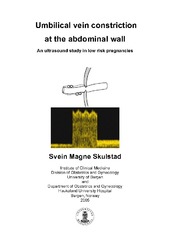| dc.description.abstract | The umbilical vein is the only vessel supplying the fetus with blood supplying oxygen and nutrients from the placenta. Case reports indicate that the fetal end of the umbilical cord is susceptible to mechanical complications. Hypothesis: We assume that umbilical ring constriction may affect the umbilical vein and have haemodynamic effects on fetal development and birth. Aims: To describe the occurrence and degree of umbilical venous constriction in low risk–pregnancies. To establish reference ranges. To determine whether such a constriction has a haemodynamic effect, or any effect on fetal development or perinatal outcome. Material and methods: 384 low–risk singleton pregnancies were included in the cross–sectional studies after written consent and ethical approval. 2D–imaging, colour Doppler and pulsed Doppler were used to measure diameters and blood velocity in the umbilical vein before, at or beyond the abdominal wall. All blood flow velocimetry was performed during fetal quiescence. Perinatal outcome was noted. Results: From 13 weeks onwards, after the period of physiological umbilical herniation, umbilical venous constriction was noted in increasing numbers and severity until 19 weeks of gestation (paper I). For the latter half of the pregnancy, during gestational weeks 20–40, the pattern remained constant; 41/191 (21%) had a venous constriction corresponding to a diameter reduction to the half, while the corresponding venous blood velocity increment was ≥300%, and 5% of the fetuses had velocities ≥107 cm/s, which is exceptionally high compared with other blood velocities in the body, whether arterial or venous (paper II). The reproducibility study showed that the measurements of venous blood velocity in the cord and at the umbilical ring had SD of 0.58 and 1.83 cm/s respectively and that the diameter measurements both at the umbilical ring and at the cord had a mean SD of 0.07 mm (paper II). The incidence of umbilical venous pulsation was higher at the umbilical ring in the abdominal wall, 242/279 (87%) than in the cord, 43/198 (22%) or intra–abdominally, 84/277 (30%). When pulsation was observed intra–abdominally, the pulsatility was not different from that at the umbilical ring. The lowest pulsatility was found in the cord vein, where the largest vein diameter was found (paper III). Umbilical venous constriction had a significant negative correlation to the birthweight/placental weight ratio in male but not in female fetuses. Umbilical venous constriction was also associated with and increased length of the cord, but only in female fetuses. Constriction was also associated with Apgar score ≤7 at one minute after birth but not after five, and was not associated with emergency delivery (paper IV). Conclusions: The umbilical ring seams to tighten in the following weeks after the period of physiological herniation, causing an increasing number and degree of umbilical vein constriction. After 19 weeks of gestation, the occurrence of umbilical vein constriction is constant until term. The degree of constriction can be considerable, and in 20% of the fetuses the umbilical vein diameter is ≤50% of that in the cord. We have established reference ranges. Within physiological ranges, i.e. in a low–risk population, such constrictions have a haemodynamic effect leading to increased incidence of pulsations and gender specific effects on fetal, cordal and placental growth. The significant effect on Apgar score at one minute warrants further studies of the effect of extreme constriction on perinatal morbidity. | en_US |
